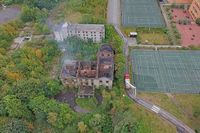On the evening of August 21, 2025, the historic skyline of Liverpool was dramatically altered as flames consumed one of its most treasured landmarks. Woolton Hall, a Grade I-listed manor house with centuries of history etched into its walls, was gutted by a large fire that drew the attention and concern of the entire city. The incident quickly took a shocking turn when authorities arrested a 14-year-old girl in connection with the blaze, sparking a wave of questions about the circumstances leading up to the catastrophic event and what the future holds for the iconic estate.
According to reporting from The Independent, emergency services rushed to the scene after reports of a major fire at the abandoned Woolton Hall, a site that has long fascinated locals and historians alike. The fire, described by witnesses as "large" and "devastating," quickly engulfed the building, with flames visible from several streets away. Efforts to contain the blaze lasted for hours, as firefighters worked tirelessly to prevent it from spreading to nearby properties.
Woolton Hall, often celebrated as one of Liverpool’s finest surviving examples of 18th-century architecture, has stood empty for years, its grand façade and elegant interiors largely left to the elements. The manor’s status as a Grade I-listed building marks it as a structure of exceptional interest, placing it among the top 2.5% of protected buildings in England. Its loss, even if partial, represents a significant blow to the city’s cultural and architectural heritage.
The arrest of a 14-year-old girl in connection with the fire has added a layer of complexity to the unfolding story. Merseyside Police confirmed the arrest on the evening of the incident, though details about the girl’s identity or possible motives have not been released due to her age. The police statement, as reported by The Independent, noted: "A 14-year-old girl was arrested after a fire gutted a Grade I-listed abandoned manor house known as Woolton Hall in Liverpool." The investigation is ongoing, with authorities appealing to the public for any information that might shed light on the circumstances surrounding the fire.
For many in Liverpool, the fire at Woolton Hall is not just a local news story—it’s a personal loss. The manor has long been a symbol of the city’s rich history, its stately rooms having once hosted prominent families, grand events, and, in more recent years, curious urban explorers and ghost hunters. The building’s abandonment in recent decades made it a target for vandalism and decay, but it also became a canvas for the city’s imagination, inspiring stories, photographs, and even film shoots.
Local residents expressed a mix of sadness and frustration as news of the fire spread. One neighbor, who asked not to be named, told The Independent, "It’s heartbreaking to see a piece of our history go up in flames. Woolton Hall has been part of this community for generations." Others lamented the manor’s long period of neglect, suggesting that more could have been done to protect and preserve the building before tragedy struck.
The history of Woolton Hall stretches back to the early 1700s, when it was constructed for the Molyneux family, prominent landowners in the region. Over the centuries, the manor changed hands several times, serving as a private residence, a school, and even a hospital during World War II. Its architectural features—including ornate plasterwork, sweeping staircases, and grand reception rooms—earned it Grade I-listed status, a designation reserved for buildings of "exceptional interest."
Despite its storied past, Woolton Hall’s fortunes declined in the late 20th century. Efforts to find new uses for the property repeatedly stalled, and by the 2000s, the building was largely abandoned. Urban explorers and amateur historians continued to document its slow decay, sharing photos of peeling wallpaper, broken windows, and graffiti-tagged corridors on social media. Yet for many, the hope remained that Woolton Hall could one day be restored to its former glory.
The fire has reignited debates about the stewardship of historic buildings in Liverpool and across the UK. Preservationists argue that more proactive measures are needed to protect vulnerable sites, especially those left vacant for extended periods. The fate of Woolton Hall, they warn, could serve as a cautionary tale for other heritage properties at risk of neglect and vandalism.
For now, the immediate focus remains on the investigation into the fire and the circumstances that led to the arrest of the 14-year-old girl. Merseyside Police have urged anyone with information to come forward, emphasizing the importance of community support in uncovering the truth. The girl, whose name has not been released, is being questioned by authorities, and her case is expected to be handled with sensitivity due to her age.
In the days following the fire, local officials and heritage groups have begun assessing the extent of the damage to Woolton Hall. Early reports suggest that much of the interior has been destroyed, though the full impact on the building’s structural integrity is still being determined. Conservation experts are expected to play a key role in evaluating whether any elements of the manor can be salvaged or restored.
The loss of Woolton Hall is a stark reminder of the challenges facing historic buildings in modern cities. As urban landscapes evolve and economic pressures mount, abandoned structures often become vulnerable to neglect, vandalism, and, as in this case, catastrophic events. The fire has prompted renewed calls for investment in heritage preservation, with advocates urging both public and private stakeholders to prioritize the protection of culturally significant sites.
As Liverpool comes to terms with the aftermath of the fire, the story of Woolton Hall serves as both a warning and a call to action. The manor’s fate now hangs in the balance, its future uncertain but its legacy firmly etched into the city’s collective memory. Whether through restoration, commemoration, or renewed debate about heritage protection, the events of August 21, 2025, will not soon be forgotten by those who cherish Liverpool’s past—and hope to safeguard its future.
The investigation continues, and the city waits anxiously for answers, hoping that lessons learned from Woolton Hall’s tragic end might help preserve what remains of its historic treasures.




